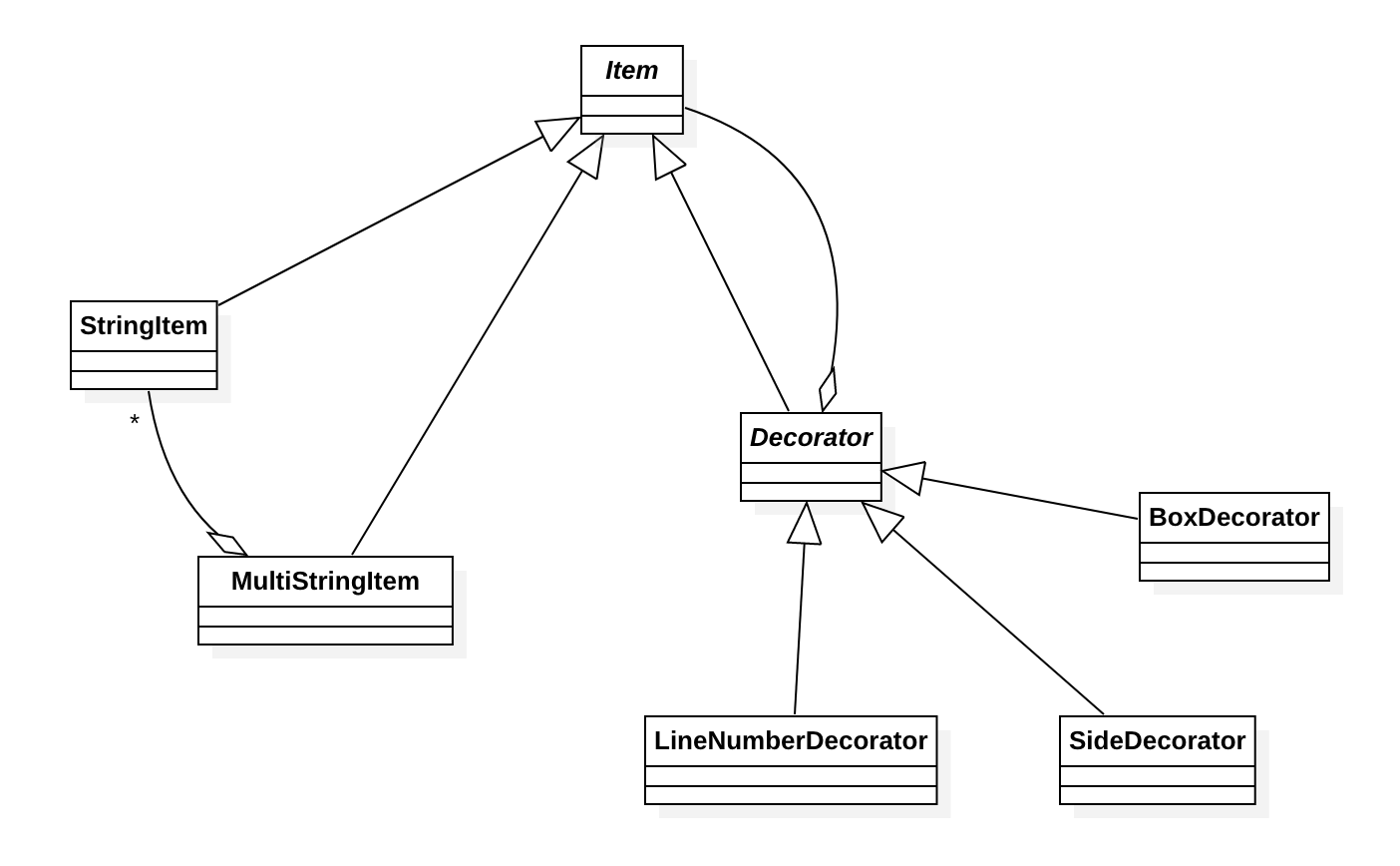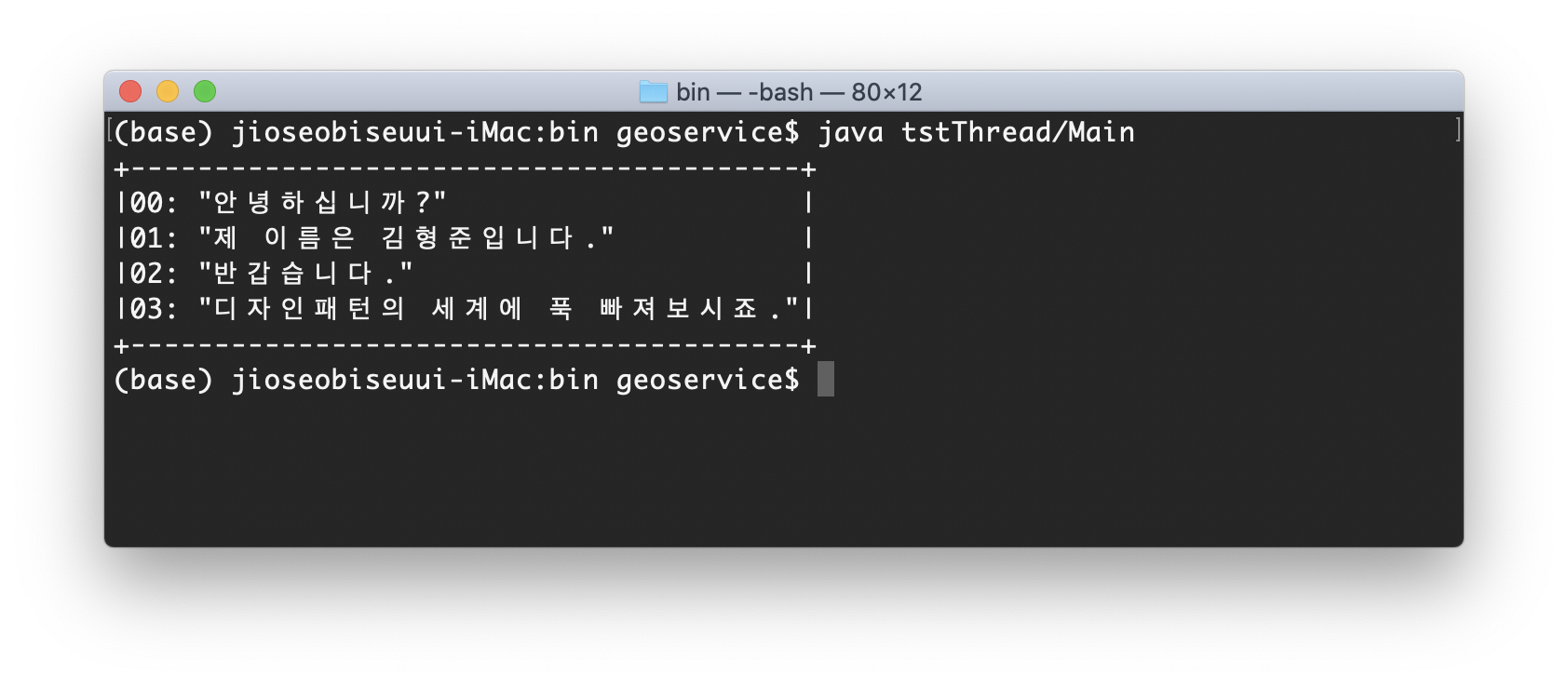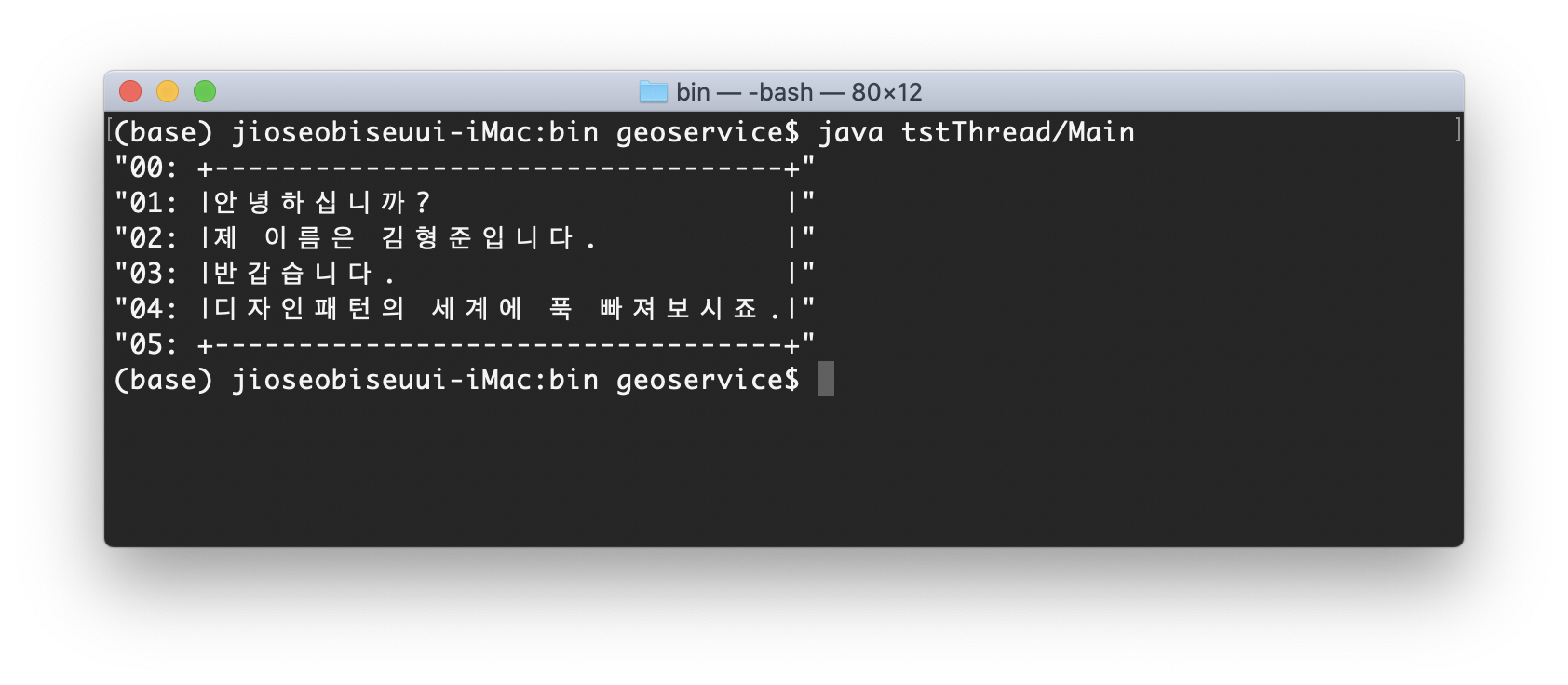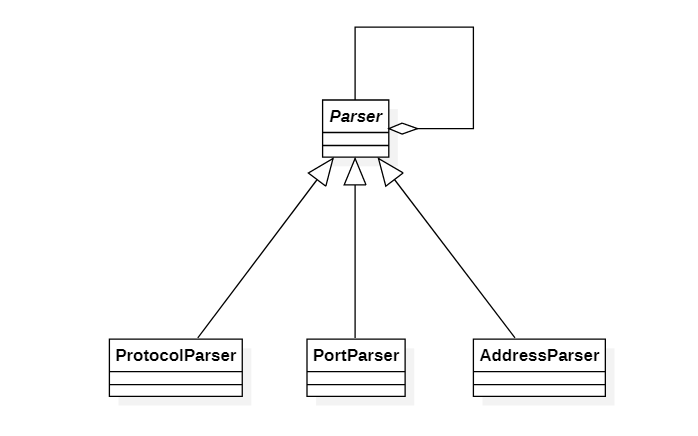패턴명칭
Decorator
필요한 상황
어떤 기능을 기준으로 다른 여러가지 종속적인 기능들을 효과적으로 추가할 수 있는 패턴이다.
예제 코드

Item은 기준이 되는 기능과 장식처럼 추가할 수 있는 종속적인 기능을 동일한 개념으로 간주하기 위한 클래스이다. StringItem과 MultiStringItem이 기준이 되는 기능이고, Decorator가 종속적인 기능이다. 종속적인 기능은 이 Decorator를 상속받아 효율적으로 추가할 수 있다. 먼저 Item 클래스는 다음과 같다.
package tstThread;
import java.io.UnsupportedEncodingException;
public abstract class Item {
public abstract int getHeight();
public abstract int getMaxWidth() throws UnsupportedEncodingException;
public abstract int getWidth(int index) throws UnsupportedEncodingException;
public abstract String getContent(int index) throws UnsupportedEncodingException;
public void print() throws UnsupportedEncodingException {
int height = getHeight();
for(int i=0; i<height; i++) {
String content = getContent(i);
System.out.println(content);
}
}
}
기준이 되는 기본 기능인 StringItem은 하나의 문자열을 처리하며 다음과 같다.
package tstThread;
import java.io.UnsupportedEncodingException;
public class StringItem extends Item {
private String content;
public StringItem(String content) {
this.content = content;
}
@Override
public int getHeight() {
return 1;
}
@Override
public int getMaxWidth() throws UnsupportedEncodingException {
return content.getBytes("euc-kr").length;
}
@Override
public String getContent(int index) {
return content;
}
@Override
public int getWidth(int index) throws UnsupportedEncodingException {
return getMaxWidth();
}
}
마찬가지로 기본이 되는 기능인 MultiStringItem은 StringItem을 여러개 가질 수 있어서 여러개의 문자열을 처리할 수 있으며 코드는 다음과 같다.
package tstThread;
import java.io.UnsupportedEncodingException;
import java.util.ArrayList;
import java.util.Iterator;
public class MultiStringItem extends Item {
private ArrayList<StringItem> strings = new ArrayList<StringItem>();
public MultiStringItem() {}
@Override
public int getHeight() {
return strings.size();
}
@Override
public int getMaxWidth() throws UnsupportedEncodingException {
Iterator<StringItem> iter = strings.iterator();
int maxWidth = 0;
while(iter.hasNext()) {
Item stringItem = iter.next();
int width = stringItem.getMaxWidth();
if(width > maxWidth) maxWidth = width;
}
return maxWidth;
}
@Override
public String getContent(int index) throws UnsupportedEncodingException {
StringItem item = strings.get(index);
return item.getContent(index);
}
public void addItem(StringItem item) {
strings.add(item);
}
@Override
public int getWidth(int index) throws UnsupportedEncodingException {
return strings.get(index).getMaxWidth();
}
}
기본 기능에 장식처럼 또 다른 기능을 위한 Decorator 클래스는 다음과 같다.
package tstThread;
public abstract class Decorator extends Item {
protected Item item;
public Decorator(Item item) {
this.item = item;
}
}
Decorator의 item 필드가 장식할 대상이 되는 객체이다. 즉 Decorator는 기본 기능 뿐만 아니라 Decorator에 대한 보조 기능도 장식할 수 있다. 이제 이 Decorator에 대한 구체적인 파생 클래스들을 보자. 먼저 SideDecorator이다.
package tstThread;
import java.io.UnsupportedEncodingException;
public class SideDecorator extends Decorator {
private Character ch;
public SideDecorator(Item item, Character ch) {
super(item);
this.ch = ch;
}
@Override
public int getMaxWidth() throws UnsupportedEncodingException {
return item.getMaxWidth() + 2;
}
@Override
public String getContent(int index) throws UnsupportedEncodingException {
return ch + item.getContent(index) + ch;
}
@Override
public int getHeight() {
return item.getHeight();
}
@Override
public int getWidth(int index) throws UnsupportedEncodingException {
return item.getWidth(index) + 2;
}
}
다음은 LineNumberDecorator이다.
package tstThread;
import java.io.UnsupportedEncodingException;
public class LineNumberDecorator extends Decorator {
public LineNumberDecorator(Item item) {
super(item);
}
@Override
public int getHeight() {
return item.getHeight();
}
@Override
public int getMaxWidth() throws UnsupportedEncodingException {
return item.getMaxWidth() + 4;
}
@Override
public int getWidth(int index) throws UnsupportedEncodingException {
return item.getWidth(index) + 4;
}
@Override
public String getContent(int index) throws UnsupportedEncodingException {
return String.format("%02d", index) + ": " + item.getContent(index);
}
}
BoxDecorator는 다음과 같다.
package tstThread;
import java.io.UnsupportedEncodingException;
public class BoxDecorator extends Decorator {
public BoxDecorator(Item item) {
super(item);
}
@Override
public int getHeight() {
return item.getHeight()+2;
}
@Override
public int getMaxWidth() throws UnsupportedEncodingException {
return item.getMaxWidth() + 2;
}
@Override
public int getWidth(int index) throws UnsupportedEncodingException {
return item.getWidth(index) + 2;
}
@Override
public String getContent(int index) throws UnsupportedEncodingException {
int maxWidth = this.getMaxWidth();
if(index == 0 || index == getHeight()-1) {
StringBuilder sb = new StringBuilder();
sb.append('+');
for(int i=0; i<maxWidth-2; i++) {
sb.append('-');
}
sb.append('+');
return sb.toString();
} else {
return '|' + item.getContent(index-1) + makeTailString(maxWidth - getWidth(index-1));
}
}
private String makeTailString(int count) {
StringBuilder sb = new StringBuilder();
for(int i=0; i<count; i++) {
sb.append(' ');
}
sb.append('|');
return sb.toString();
}
}
지금까지의 클래스를 사용하는 코드는 다음과 같다.
package tstThread;
import java.io.UnsupportedEncodingException;
public class Main {
public static void main(String[] args) throws UnsupportedEncodingException {
StringItem item1 = new StringItem("안녕하십니까?");
StringItem item2 = new StringItem("제 이름은 김형준입니다.");
StringItem item3 = new StringItem("반갑습니다.");
StringItem item4 = new StringItem("디자인패턴의 세계에 푹 빠져보시죠.");
MultiStringItem multiStringItem = new MultiStringItem();
multiStringItem.addItem(item1);
multiStringItem.addItem(item2);
multiStringItem.addItem(item3);
multiStringItem.addItem(item4);
Decorator sideDecorator = new SideDecorator(multiStringItem, '\"');
Decorator lineNumberDecorator = new LineNumberDecorator(sideDecorator);
Decorator boxDecorator = new BoxDecorator(lineNumberDecorator);
boxDecorator.print();
}
}
기본 기능인 multiStringItem에 3개의 장식인 sideDecorator, lineNumberDecorator, boxDecorator을 적용한 예로 실행 결과는 다음과 같다.

다음은 기본 기능인 multiStringItem은 그대로 사용하고 3개의 장식의 순서를 달리한 예이다.
package tstThread;
import java.io.UnsupportedEncodingException;
public class Main {
public static void main(String[] args) throws UnsupportedEncodingException {
StringItem item1 = new StringItem("안녕하십니까?");
StringItem item2 = new StringItem("제 이름은 김형준입니다.");
StringItem item3 = new StringItem("반갑습니다.");
StringItem item4 = new StringItem("디자인패턴의 세계에 푹 빠져보시죠.");
MultiStringItem multiStringItem = new MultiStringItem();
multiStringItem.addItem(item1);
multiStringItem.addItem(item2);
multiStringItem.addItem(item3);
multiStringItem.addItem(item4);
Decorator boxDecorator = new BoxDecorator(multiStringItem);
Decorator lineNumberDecorator = new LineNumberDecorator(boxDecorator);
Decorator sideDecorator = new SideDecorator(lineNumberDecorator, '\"');
sideDecorator.print();
}
}
실행 결과는 다음과 같다.

이 글은 소프트웨어 설계의 기반이 되는 GoF의 디자인패턴에 대한 강의자료입니다. 완전한 실습을 위해 이 글에서 소개하는 클래스 다이어그램과 예제 코드는 완전하게 실행되도록 제공되지만, 상대적으로 예제 코드와 관련된 설명이 함축적으로 제공되고 있습니다. 이 글에 대해 궁금한 점이 있으면 댓글을 통해 남겨주시기 바랍니다.




